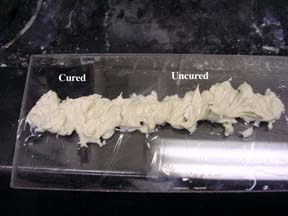


Advantages of Frontal Polymerization: long pot life with very rapid cure.
For information on licensing of frontal polymerization technology
We have been successful in demonstrating the tremendous advantages of this
technology including fast cure times, use of either transparent or opaque fillers,
ability to work/rework composite until activated by light or small amount of
heat, and ultra-low energy consumption. By choice of materials it will be possible
to formulate resins that cure to composites with properties ranging form rubbery
and pliable to hard and impact resistant. The thermal stability of the cured
composites is exceptional.
Composites are traditionally cured by using a two-part formulation that reacts
upon mixing or by using an autoclave to cure the formulation at a high temperature.
BONDO and fiberglass are cured by mixing two components, one of which uses
a redox reaction to slowly initiate the polymerization at room temperature.
Five-minute epoxy is also a two-part formulation that starts reacting upon
mixing. The disadvantage is that once the components are mixed, the system
is reacting and so the time for setting up the materials is limited. Large
composites such as for aerospace applications are usually cured in a large
oven, or autoclave.
Frontal polymerization avoids the problem of a system curing at room temperature
and of the necessity of mixing two components. All the components required
for reaction are present in the formulation. All that is required is the
initial input of energy to start the front. Also, because the reaction uses
its own heat release to drive the process, no autoclave is necessary.
1) Rapid repair of structures. A putty containing reagents and filler can
be forced into a hole and the front ignited, allowing repair in seconds. The
structures could be a spacecraft or a stealth composite-structure on a ship.
Any structure that needs repair rapidly would benefit from our ‘super
fast BONDO’. We are working with Lockheed on a process for rapid repair
of aircraft and with a consumer company for rapid repair.
Figure 1 illustrates how a hole was filled with a putty. A front was ignited
with a lamp, starting the front that cured the material to a rock-hard form
within seconds. There is no limit to the diameter or depth of the hole that



Figure 1. A hole was drilled in block of polyethylene. The resin and filler were placed into the hole. The front was ignited with a heat lamp, and in seconds a rock hard composite is formed
All Movies are in Quicktime. To download the QuickTime plugin.
Frontal polymerization can be used to repair a large hole. In this movie (click on the image) a nail is inserted in the reactive putty, and then the front is ignited with a soldering iron.
2) Figure 2 illustrates that the putty can be free standing and still support
a front. Such materials could be used to provide a seal along a crack or
around a pipe to provide a concrete-like seal.

Figure 2.
3) In situ fabrication of parts could be accomplished using molds and the
ignition of frontal polymerization to rapidly produce the part with low
energy consumption
in very short times.